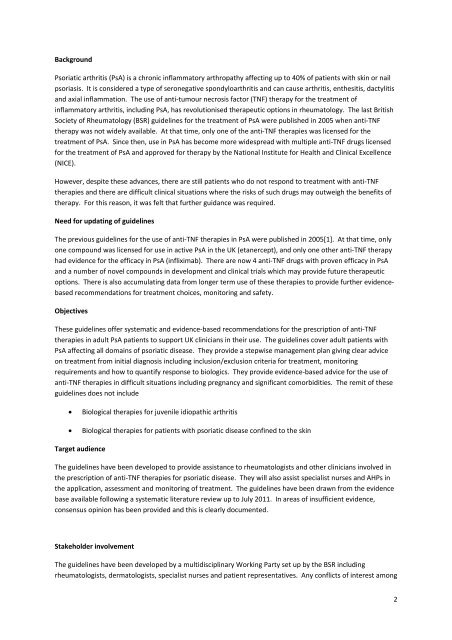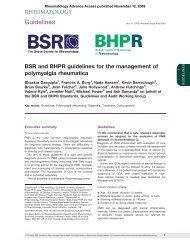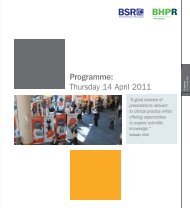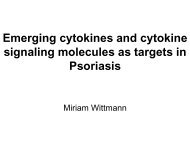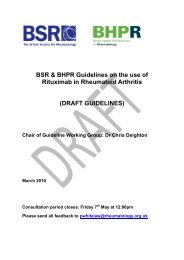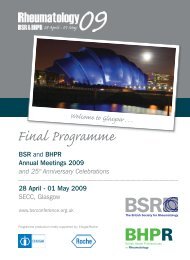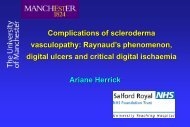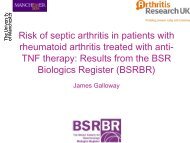Guidelines for the treatment of psoriatic arthritis with biologics
Guidelines for the treatment of psoriatic arthritis with biologics
Guidelines for the treatment of psoriatic arthritis with biologics
You also want an ePaper? Increase the reach of your titles
YUMPU automatically turns print PDFs into web optimized ePapers that Google loves.
Background<br />
Psoriatic <strong>arthritis</strong> (PsA) is a chronic inflammatory arthropathy affecting up to 40% <strong>of</strong> patients <strong>with</strong> skin or nail<br />
psoriasis. It is considered a type <strong>of</strong> seronegative spondylo<strong>arthritis</strong> and can cause <strong>arthritis</strong>, en<strong>the</strong>sitis, dactylitis<br />
and axial inflammation. The use <strong>of</strong> anti‐tumour necrosis factor (TNF) <strong>the</strong>rapy <strong>for</strong> <strong>the</strong> <strong>treatment</strong> <strong>of</strong><br />
inflammatory <strong>arthritis</strong>, including PsA, has revolutionised <strong>the</strong>rapeutic options in rheumatology. The last British<br />
Society <strong>of</strong> Rheumatology (BSR) guidelines <strong>for</strong> <strong>the</strong> <strong>treatment</strong> <strong>of</strong> PsA were published in 2005 when anti‐TNF<br />
<strong>the</strong>rapy was not widely available. At that time, only one <strong>of</strong> <strong>the</strong> anti‐TNF <strong>the</strong>rapies was licensed <strong>for</strong> <strong>the</strong><br />
<strong>treatment</strong> <strong>of</strong> PsA. Since <strong>the</strong>n, use in PsA has become more widespread <strong>with</strong> multiple anti‐TNF drugs licensed<br />
<strong>for</strong> <strong>the</strong> <strong>treatment</strong> <strong>of</strong> PsA and approved <strong>for</strong> <strong>the</strong>rapy by <strong>the</strong> National Institute <strong>for</strong> Health and Clinical Excellence<br />
(NICE).<br />
However, despite <strong>the</strong>se advances, <strong>the</strong>re are still patients who do not respond to <strong>treatment</strong> <strong>with</strong> anti‐TNF<br />
<strong>the</strong>rapies and <strong>the</strong>re are difficult clinical situations where <strong>the</strong> risks <strong>of</strong> such drugs may outweigh <strong>the</strong> benefits <strong>of</strong><br />
<strong>the</strong>rapy. For this reason, it was felt that fur<strong>the</strong>r guidance was required.<br />
Need <strong>for</strong> updating <strong>of</strong> guidelines<br />
The previous guidelines <strong>for</strong> <strong>the</strong> use <strong>of</strong> anti‐TNF <strong>the</strong>rapies in PsA were published in 2005[1]. At that time, only<br />
one compound was licensed <strong>for</strong> use in active PsA in <strong>the</strong> UK (etanercept), and only one o<strong>the</strong>r anti‐TNF <strong>the</strong>rapy<br />
had evidence <strong>for</strong> <strong>the</strong> efficacy in PsA (infliximab). There are now 4 anti‐TNF drugs <strong>with</strong> proven efficacy in PsA<br />
and a number <strong>of</strong> novel compounds in development and clinical trials which may provide future <strong>the</strong>rapeutic<br />
options. There is also accumulating data from longer term use <strong>of</strong> <strong>the</strong>se <strong>the</strong>rapies to provide fur<strong>the</strong>r evidencebased<br />
recommendations <strong>for</strong> <strong>treatment</strong> choices, monitoring and safety.<br />
Objectives<br />
These guidelines <strong>of</strong>fer systematic and evidence‐based recommendations <strong>for</strong> <strong>the</strong> prescription <strong>of</strong> anti‐TNF<br />
<strong>the</strong>rapies in adult PsA patients to support UK clinicians in <strong>the</strong>ir use. The guidelines cover adult patients <strong>with</strong><br />
PsA affecting all domains <strong>of</strong> <strong>psoriatic</strong> disease. They provide a stepwise management plan giving clear advice<br />
on <strong>treatment</strong> from initial diagnosis including inclusion/exclusion criteria <strong>for</strong> <strong>treatment</strong>, monitoring<br />
requirements and how to quantify response to <strong>biologics</strong>. They provide evidence‐based advice <strong>for</strong> <strong>the</strong> use <strong>of</strong><br />
anti‐TNF <strong>the</strong>rapies in difficult situations including pregnancy and significant comorbidities. The remit <strong>of</strong> <strong>the</strong>se<br />
guidelines does not include<br />
• Biological <strong>the</strong>rapies <strong>for</strong> juvenile idiopathic <strong>arthritis</strong><br />
• Biological <strong>the</strong>rapies <strong>for</strong> patients <strong>with</strong> <strong>psoriatic</strong> disease confined to <strong>the</strong> skin<br />
Target audience<br />
The guidelines have been developed to provide assistance to rheumatologists and o<strong>the</strong>r clinicians involved in<br />
<strong>the</strong> prescription <strong>of</strong> anti‐TNF <strong>the</strong>rapies <strong>for</strong> <strong>psoriatic</strong> disease. They will also assist specialist nurses and AHPs in<br />
<strong>the</strong> application, assessment and monitoring <strong>of</strong> <strong>treatment</strong>. The guidelines have been drawn from <strong>the</strong> evidence<br />
base available following a systematic literature review up to July 2011. In areas <strong>of</strong> insufficient evidence,<br />
consensus opinion has been provided and this is clearly documented.<br />
Stakeholder involvement<br />
The guidelines have been developed by a multidisciplinary Working Party set up by <strong>the</strong> BSR including<br />
rheumatologists, dermatologists, specialist nurses and patient representatives. Any conflicts <strong>of</strong> interest among<br />
2


